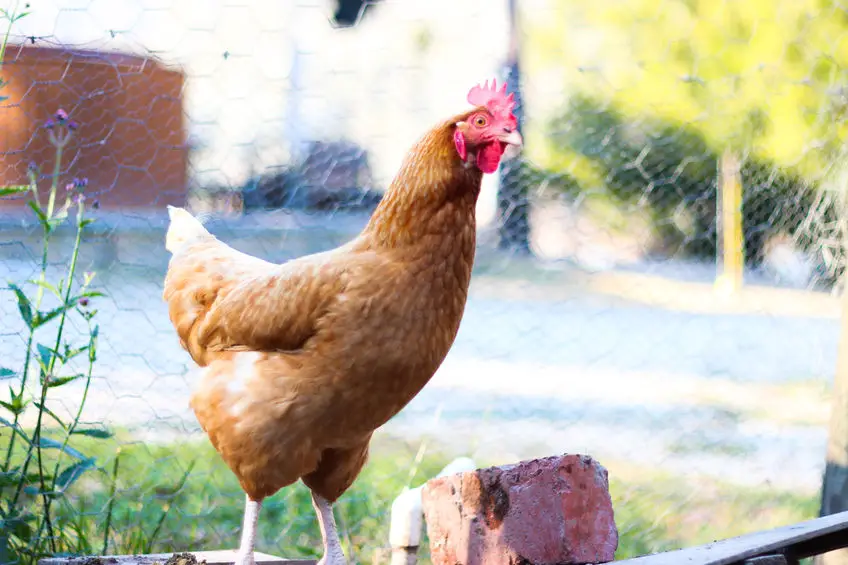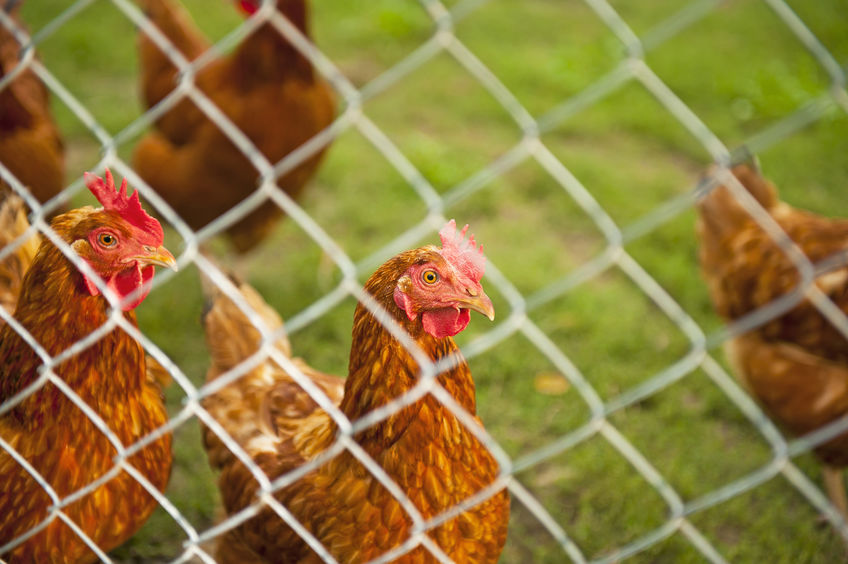We all want to protect our chickens from predators and from ‘flyin the coop.’ This means we need to choose the best wire mesh for a chicken run. Similar to how there are countless amounts of chicken breeds, there are plenty of different wire meshes to use.
You also have to keep factors like predators, location, weather, and the number of animals you have in mind, which makes choosing chicken wire for your coop, run, or poultry fencing very difficult for most chicken owners.
Luckily for you, we have simplified the process for you. We’ve found the five most popular wires including hardware cloth, bird netting, chain link fencing, chicken wire, and safety fence. Keep reading to find more about all the different types of wires.

First of All, What Is A Chicken Run?
According to My Pet Chicken, A chicken run is, for those of you who don’t know, a fenced or enclosed space you create for your chickens. There is an indoor and outdoor space.
The indoor space is where they sleep and lay eggs. Depending on the set up it can also be where the flock eats and drinks.
The outdoor space is where they fodder in grass, bask in the sun, and scratch in the dirt. Normally, to keep your chickens safe, you’ll need to enclose the space with a wire of sorts. Thus, the importance of choosing the right wire enclosure is key.
Why Is It Important to Choose the Right Fence?
When you have chickens, it’s important to keep them safe from predators and egg thieves like snakes, rats, dogs, foxes, and goannas, as well as making sure that your chicken can not jump or fly out of its coop.
Their protection should be at the forefront of your mind when you’re picking out which wire covering to use, which is why picking out a secure option is so important for chicken owners.
You need something that fits all your needs. There are many different chicken wires with contrasting gauges and techniques, but we decided to analyze the five most popular types: hardware cloth, chicken wire, bird netting, chain link fencing, and safety fence.
Chicken Run Enclosure Options
The most common types of chicken run enclosures are included next. We’ve divided them into two categories:
1) Chicken Run covering options that can completely envelop the run i.e. covering the sides AND the top to protect from both aerial and ground predators: These choices are hardware cloth, chicken wire, and bird netting.
2) Run options that can cover the sides of the run but not over the top of the run: These include chain link and safety fencing.
First, the full run enclosure options!

Option 1: Hardware Cloth
Hardware cloth is square or rectangular grid woven or welded wires. It’s usually available in galvanized, stainless steel, and bore steel. It doesn’t bend easily and has small holes, which are 1/4 inch to 1/2 inch or larger. It’s rigid design makes a strong and safe wire mesh enclosure.
To deter predators that can dig (dogs, raccoons, foxes, etc), hardware cloth should be buried 12 inches into the ground. Hardware cloth is also usually considered a better choice than chicken wire because it’s manufactured from a stronger gauge metal.

Option 2: Chicken Wire
Chicken wire, also known as Hex Netting, is a twisted steel wire mesh that has a hexagonally shaped opening. It can be galvanized. Usually, depending on where you purchase your wire, it is made of thin steel. This means a predator (like a dog or coyote) that is intent on breaking through can easily rip the chicken wire.
If you don’t have to worry about large predators, this is a cheap and simple option. However, even though it is not a secure wire, it can also be an easy temporary band-aid until you get stronger fencing in place..

Option 3: Bird Netting
Bird netting is perfect for you and your chickens if you often have to deal with aerial predators or your chickens escaping your wire by flying or jumping. Using a nylon cord, it is created to have a two-inch square shape.
It creates a roof over your chickens to prevent hawks or falcons from entering or your chickens from leaving. Bird netting can be purchased in various lengths and is most commonly bought in the color black. The downside to this is that it can be quite perplexing to put together, easily getting all tangled up if not assembled correctly.
There are variances in the way bird netting is made. Some types of bird netting will be stronger than other kinds, depending on the type of knots used. It can come in knotless netting or knotted netting. Knotted will cost more, but will be of higher quality and strength. For more information on the best types of bird netting, see this article.
Below is a video demonstrating how to install bird netting.
Now on to the options that cover the sides of the run only.

Option 1: Chain Link Fencing
If you live near large predators (for example bears, coyotes, cougars) and want to provide stronger protection to your chickens, chain link fencing is your perfect choice. Most large animals like bears can easily break thin netting, but luckily chain links are heavier than most of the other fencing options, using much heavier gauge steel.
The downside to getting chain link fencing is that it’s more expensive than most wire fencing options because of its quality steel material. It’s heavier and more laborious to install than other types of fencing listed but a great option if you need something durable.

Option 2: Safety Fence
Safety fences are usually found on construction sites, but recently some have used these delicate fences for their chickens. While safety fences are an option, they aren’t by any means the best option.
Safety fences are made out of plastic with large holes, they usually don’t stay up for too long and are definitely not effective in keeping predators out. Although it can be a temporary solution, there are much better temporary wire fencing options. More likely than not, the plastic will start to droop if you keep it for too long. The advantage is its affordability.
But to play devil’s advocate for a bit, if predators are not an issue and you take the time to install plenty of support posts, it can be a viable option. After all, if you’re only needing the fence to keep chickens in the run, this can work great.
However, you’ll have to live with the color selection which is usually bright orange, green, or some other very bright color. But if you really want to get started and don’t have the funds for a more expensive run, then it’ll work for a temporary solution.
As with many things in farming, you have to get creative sometimes!
Mix and Match
The simplest option, if you want an enclosed run, is to simply use hardware cloth or chicken wire for the walls and roof. Once the framing is in, just staple or nail the hardware cloth onto it.
But there is room for creativity as well, a way to combine a few of the options discussed.
- Hardware Cloth/Chicken Wire – Use hardware cloth for the walls of the run and chicken wire for the top (or roof). The hardware cloth will keep out the larger 4 legged predators. And unless you have some eagles or hawks with herculean strength in your area, the chicken wire will keep them from flying in.
- Hardware Cloth/Bird Netting – Like hardware cloth/chicken wire combination, this pairing can work well if you have ground predators but where aerial predators aren’t as big of an issue. Use hardware cloth for the sides and the bird netting for the roof.
- Chicken Wire/Bird Netting – This combination can be good if you have few predators of any kind or just need something to keep the chickens in the run.
- Chain link fencing/Chicken Wire or bird netting – Great combo for if you have issues with predators of the 4 legged kind AND of the feathered varieties.
- Chain link fencing/hardware cloth – The ultimate in securing your flock from predators of all kinds. It will cost more money to install but will be one of the most solid options in protecting your flock while they’re in the run.
- Whatever combination will work for you – the previous options are just a few ideas for your run. But you can mix and match however you like. Heck, you can even include other materials not included in our list of run enclosure materials.
Finally, What’s the Best Wire for Chicken Run?
Realistically, run enclosures that work for some people will not work for others. But overall, hardware cloth is the best wire run covering. It’s accessible, easy to use, and sturdy enough to handle chickens. With that being said, we also recommend:
- Purchasing a chicken wire with a 1.2mm gauge for strength
- For strength, finding strong materials like welded galvanized steel chicken wire
- Getting a wire mesh of 10mm x 10mm for protection from predators
- Making sure to lay mesh around 150 mm under each side of the perimeter for even more protection
- Either 1/2 inch or 1/4 inch squares will work fine
In conclusion, choosing the best wire enclosure for your flock is very important. You have to take details like location, predators, security, and the number of chickens you have into account when you pick your wire materials. It gets even more complicated when you have to weigh the pros and cons of wires and fencing kinds like hardware cloth, chicken wire, and chain link fencing.
Overall, we’ve found that hardware cloth is the best wire for a chicken run for most chicken owners. It’s stronger than most, provides protection from the average predator, and is reasonably priced. If you’re wanting to buy hardware cloth, head to your local hardware store or look online.
Thank you for reading and happy “chickening!”


